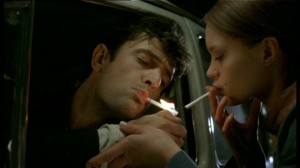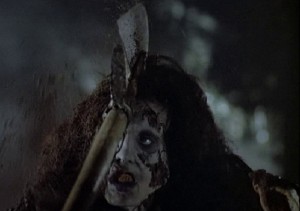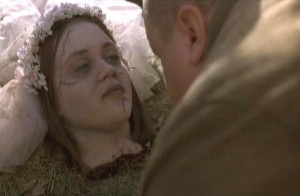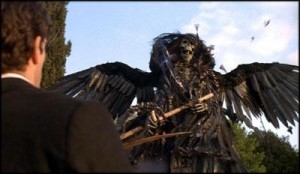Dellamorte Dellamore
 I first saw Dellamorte Dellamore in the theater in May of 1996 under the US title of Cemetery Man. I remember being very amused for the most part, it was a film that had a weird rhythm to it, an anything goes quality that certainly I didn’t see in most mainstream fare. At a certain point in the film, there is what most might call a logical conclusion, sort of a humorously gruesome way to wrap things up. Expecting the credits to start rolling, I looked at my watch and noticed that it had only been an hour, and from the reviews I read, they all stated that the film was about an hour and forty minutes.
I first saw Dellamorte Dellamore in the theater in May of 1996 under the US title of Cemetery Man. I remember being very amused for the most part, it was a film that had a weird rhythm to it, an anything goes quality that certainly I didn’t see in most mainstream fare. At a certain point in the film, there is what most might call a logical conclusion, sort of a humorously gruesome way to wrap things up. Expecting the credits to start rolling, I looked at my watch and noticed that it had only been an hour, and from the reviews I read, they all stated that the film was about an hour and forty minutes.
What happened after that scene was utterly bewildering, and after the movie was over, my mouth was literally wide open, as if the movie had caused something in my head to break. I left the theater and walked around in a daze for three hours, my mouth agape the entire time. For a first time viewer of Dellamorte Dellamore, this is not an atypical reaction; the final act of the film will confound and confuse them. Characters that have died come back to life several different times, sometimes with a foggy recollection of their previous incarnation, sometimes not.
 But to explain Dellamorte Dellamore would not just be a mistake but missing the point. Similarly to Christophe Gans’ Brotherhood of the Wolf, director Michele Soavi jams as many genres as he can get into his film, with no qualms about not giving the audience a map. That characters come back to life in a zombie movie such as this, is not surprising. Soavi does riffs on the Evil Dead series, Re-Animator, Romero’s Dead trilogy, Jackson’s Braindead throughout, but the movie is not just a horror comedy, but a soft core porn, a political satire, and a huge dollop of Dali/Bunuel surrealism.
But to explain Dellamorte Dellamore would not just be a mistake but missing the point. Similarly to Christophe Gans’ Brotherhood of the Wolf, director Michele Soavi jams as many genres as he can get into his film, with no qualms about not giving the audience a map. That characters come back to life in a zombie movie such as this, is not surprising. Soavi does riffs on the Evil Dead series, Re-Animator, Romero’s Dead trilogy, Jackson’s Braindead throughout, but the movie is not just a horror comedy, but a soft core porn, a political satire, and a huge dollop of Dali/Bunuel surrealism.
The plot is simple, Francis Dellamorte (Rupert Everett) works and lives in the cemetery running the grounds with his assistant, the mostly mute, but occasionally grunting Gnaghi (François Hadji-Lazaro, who always seems to find interesting projects, like this, The City of Lost Children and Brotherhood of the Wolf). There is an ongoing problem with the dead coming back to life after seven days, and Dellamorte having to shoot them in the head. He makes complaints to the mayor, but they go ignored. This is where Soavi tries to slip in his unsubtle political satire. In order to file a report such as this, he has to find the right paperwork and file it in the right order, and there are jokes that seem directly lifted from Terry Gilliam’s Brazil on the subject. There is also the uncaring mayor, only caring about votes (he wonders if the mounting lists of dead people were voters), and hospital workers only caring about the bottom line, not seeing what’s right in front of them, etc.
 Everett plays Dellamorte as a sarcastic anti-hero, a performance seemingly modeled on Bruce Campbell from Evil Dead, only more composed. He is the most effective in the film because he is one of the few native English speaking actors in the film. Since it was shot in Italy, primarily with Italian actors, the entire movie was dubbed, Sergio Leone style, with Everett doing his own voice work, but others either doing it phonetically, or with another actor entirely. The lead actress, Anna Falchi, is a native Italian, and if her performance seems the most amateurish, that may be the reason. Mostly, she is on hand to get naked every so often, and lead Everett in odd directions as he develops a fixation on her.
Everett plays Dellamorte as a sarcastic anti-hero, a performance seemingly modeled on Bruce Campbell from Evil Dead, only more composed. He is the most effective in the film because he is one of the few native English speaking actors in the film. Since it was shot in Italy, primarily with Italian actors, the entire movie was dubbed, Sergio Leone style, with Everett doing his own voice work, but others either doing it phonetically, or with another actor entirely. The lead actress, Anna Falchi, is a native Italian, and if her performance seems the most amateurish, that may be the reason. Mostly, she is on hand to get naked every so often, and lead Everett in odd directions as he develops a fixation on her.
The movie looks quite low budget at times, especially with the occasional poor steadicam work. Specifically, there is a scene where the camera circles Dellamorte, Gnaghi, the mayor, his daughter, and his associates. The cameraman almost seems off balance throughout the scene. The special effects also suffer. As Falchi and Everett make love over a grave, they are observed by what look like flaming blue marshmallows, who dance about in the air. Even if you are faintly paying attention, you will notice the strings holding them up, most likely attached to a fishing rod off-screen.
But Everett, with his apathetic swagger, manages to distract you from such small things. His sardonic voiceover is sometimes amusing, sometimes obvious, and makes up for the occasional cheesy line, such as when the mayor’s daughter, Valentina, exclaims that her boyfriend is the only one who understands her for giving her a ride on his motorcycle after she’s just been vomited on. The dialogue varies like this, with an abundance of both witty (“he’s only eating me”) and groan inducing lines (“I’m the mayor!” Gunshot… “Ex”), to the point where you enjoy both, simply because Soavi decided to simply throw everything into the pot.
 Once you get to the point in the film that initially lost me, you must make a decision. Since I have seen it several times, I have figured out what makes sense to me and have gone with that conclusion ever since. Others may just decide to get sucked in by the surreal events, and enjoy it for that. Basically the movie follows its own logic for the first 57 minutes of the film (SPOILER: right after Dellamorte is bitten and the dead keep coming into his house as he shoots them one after the other) and then goes in a completely different direction. Personally, I feel that everything after that point is a hallucination, a result of what has just occurred to the main character, which completely changes how he’s seeing things. But you may comprehend it differently. At least the movie isn’t predictable.
Once you get to the point in the film that initially lost me, you must make a decision. Since I have seen it several times, I have figured out what makes sense to me and have gone with that conclusion ever since. Others may just decide to get sucked in by the surreal events, and enjoy it for that. Basically the movie follows its own logic for the first 57 minutes of the film (SPOILER: right after Dellamorte is bitten and the dead keep coming into his house as he shoots them one after the other) and then goes in a completely different direction. Personally, I feel that everything after that point is a hallucination, a result of what has just occurred to the main character, which completely changes how he’s seeing things. But you may comprehend it differently. At least the movie isn’t predictable.
This review refers to the Italian R2 disc (from Medusa), which was released long before the R1 American. The review was clearly written quite a while ago, somewhere in the neighborhood of 2004, for a defunct site called Nicheflix.
Video:
There is some edge enhancement early on but it is not an issue after the first scene. Darker scenes are quite grainy, indicative of the low budget, but not distractingly so. This Medusa disc is considerably better than the faded and discolored German R2 Laser Paradise, which was non anamorphic and letterboxed at about 1.66. This disc is anamorphic and 1.85 and looks as good as it has looked since my theatrical viewing. Colors are mostly sharp, especially during the hospital scene, but the transfer is occasionally let down by the rushed and indifferent look of the scenes that take place in town.
 Audio:
Audio:
We are given the choice of either Dolby Surround 2.0 Italian or English. Either is adequate, and not overwhelming, but it appeared to be an accurate representation.
The warped music in the opening scene seems to be in all versions (though I can’t remember the theatrical). I watched it in English, since Everett has most of the lines, but both English and Italian subtitles are provided.
Extras:
There is a rather in-depth 17 minute featurette covering the story, special effects, source of the film (it’s based on a popular comic), and actors. It is full frame, and unfortunately in Italian, even Everett is dubbed that way, and no English subtitles are provided. The same goes for the commentary, by Soavi, which even has its own Italian subtitles, but no English translation. There’s also some cast and crew bios, in Italian only.
Overall:
This is an extremely entertaining and unique movie that switches tones and genres every five minutes. At the moment, there is no R1 release and the Medusa version is better than the other available options, so I would definitely suggest this disc.



